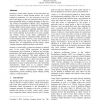Free Online Productivity Tools
i2Speak
i2Symbol
i2OCR
iTex2Img
iWeb2Print
iWeb2Shot
i2Type
iPdf2Split
iPdf2Merge
i2Bopomofo
i2Arabic
i2Style
i2Image
i2PDF
iLatex2Rtf
Sci2ools
ACSC
2006
IEEE
2006
IEEE
Human visual perception of region warping distortions
Interactive virtual reality requires at least 60 frames per second in order to ensure smooth motion. For a good immersive experience, it is also necessary to have low end-to-end latency so that user interaction does not suffer from perceptible delays in images presented to the eyes. The Address Recalculation Pipeline (ARP) architecture reduces end-to-end latency in immersive Head Mounted Display (HMD) virtual reality systems. By using the ARP in conjunction with priority rendering, different sections of the scene are updated at different rates. This reduces the overall rendering load and allows for more complex and realistic scenes. Large object segmentation in conjunction with priority rendering further reduces the overall rendering load. However, scene tearing artefacts potentially emerge and region warping was devised to alleviate this. In compensating for the tearing, region warping introduces slight distortions to the scene. Immersive virtual reality systems have humans as integr...
| Added | 10 Jun 2010 |
| Updated | 10 Jun 2010 |
| Type | Conference |
| Year | 2006 |
| Where | ACSC |
| Authors | Yang-Wai Chow, Ronald Pose, Matthew Regan, James Phillips |
Comments (0)

